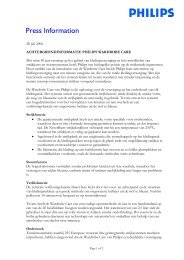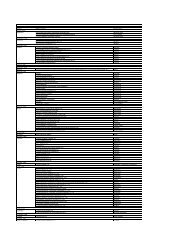by Stefano Marzano - Philips
by Stefano Marzano - Philips
by Stefano Marzano - Philips
You also want an ePaper? Increase the reach of your titles
YUMPU automatically turns print PDFs into web optimized ePapers that Google loves.
Flying<br />
over<br />
Las Vegas<br />
<strong>by</strong> <strong>Stefano</strong> <strong>Marzano</strong>
<strong>Philips</strong> Design info.design@philips.com about <strong>Philips</strong> Design: www.design.philips.com<br />
Flying over Las Vegas<br />
In 1992, <strong>Stefano</strong> <strong>Marzano</strong>, CEO and Chief Creative Director at <strong>Philips</strong> Design, gave the keynote<br />
speech at the 17th World Design Conference of the International Council of Societies (ICSID)<br />
in Ljubljana. Under the intriguing title ‘Flying over Las Vegas’, he gave a vision of the task facing<br />
designers in the coming years. The text included in this book is adapted from that speech.<br />
Index<br />
4 A vision of the future<br />
6 The new order<br />
6 Saturation point<br />
8 The unlimited market<br />
10 The other half<br />
10 The race against time<br />
12 Relevant objects<br />
14 Environmental challenge<br />
16 Interdependency<br />
18 Etica Nova
A vision of the future<br />
Some months ago, I was on board an airplane. Looking out of the window at the ground below, I could<br />
see the bright neon lights of a city standing in the middle of a desert. As you may already have guessed,<br />
its name was Las Vegas.<br />
Today, activity in Las Vegas (which actually means ‘the meadows’ in Spanish - highly inappropriate!)<br />
is geared to the lust for money, a lust which is seldom satisfied. Money and materialism are the city’s<br />
guiding principles; and this probably explains why most of the people who go there to play the slot<br />
machines seem to be so unhappy. On my own visit, I was confronted with an awesome vision of<br />
a future hell, a place or state of mind which recalled the writer Henry Miller’s expression,<br />
“the air-conditioned nightmare.”<br />
This detailed description of Las Vegas is, I think, relevant, for it gives us a warning of what the future could<br />
be like - if we are not careful. It is the type of world to which environmental carelessness and materialism<br />
supported <strong>by</strong> technology could lead us. But it is not technology that determines human destiny, but rather<br />
people themselves, in how they decides to use this technology. The future does not just happen <strong>by</strong> itself. It<br />
can be influenced <strong>by</strong> those who are prepared to shoulder the responsibility of making decisions today.<br />
Inaction<br />
is also action.<br />
The future, then, is made <strong>by</strong> those who take responsibility for it today. That means that we, too, can<br />
participate in the shaping of this future. By virtue of the enormous number of products they put onto<br />
the market, large companies play a major role in determining the quality of our lives. Such corporations<br />
should therefore shoulder their responsibility and become conscious of their power. Those of us who<br />
work for them must play our part in this.<br />
The future<br />
is made <strong>by</strong><br />
those who take<br />
responsibility<br />
for it today
The New Order<br />
Many different challenges are confronting the human race. No-one can deny that the last few years have<br />
seen dramatic changes in political, social, economical and environmental terms; and we are all naturally<br />
somewhat apprehensive about the future. We are discovering new local, ethnic and regional groupings;<br />
and this helps to explain the current crises of national identity. The old system prevented us from realizing<br />
that, instead of belonging to either the East or the West, we are in fact members of a global community.<br />
We were prevented from seeing that the problems of this community must be solved on a global basis.<br />
Saturation Point<br />
We are constantly being bombarded <strong>by</strong> messages - from advertising and the news media - that slowly<br />
but surely are ceasing to have any meaning. A similar glut of information is apparent in the products we<br />
use. They confuse us with their vast number of functions and, again, their seductive exterior merely covers<br />
a void. It is this void, or silence, which prevents us from entering into any meaningful relationship with the<br />
product: we are unable to ‘feel’ the object, just as we are unable to cope with the mass media images.<br />
In both cases, the effect is one of mental pollution: as with environmental pollution, the fundamental<br />
cause is an undue emphasis on quantity at the expense of quality.<br />
Parallel to the fragmentation of community loyalties we are witnessing around the world, we are also<br />
seeing a segmentation of consumer loyalty. Today’s consumers are increasingly individualistic. Whereas<br />
they once fell into clearly defined national, cultural or social groups (e.g., the yuppies) and acquired<br />
products (often status symbols) in order to affirm their membership of one of these groups, today<br />
they are transversal in their behavior. They will cross the social group boundaries several times during<br />
the course of the day. A highly rational purchase will be followed <strong>by</strong> a piece of impulse buying. They will<br />
eat in a luxurious restaurant one day and in a cheap pizzeria the next; wear an expensive Rolex watch<br />
along with jeans and sneakers. The consumer is moving away from group style towards individual style.<br />
The customer has become less predictable.
Values which will<br />
promote humanity’s<br />
cultural growth<br />
The Unlimited Market<br />
In both the political and the consumer scenario, chaos is the new order. And yet, far from being<br />
pessimistic about this situation, I am actually optimistic. If our limited market has now reached saturation<br />
point, and the metaphorical wall has been knocked down, then the next logical step is the unlimited<br />
market. And this, I believe, is a far more exciting place to be.<br />
In the past, the emphasis was on quantity: products were impressive for their number of functions,<br />
the number of gears or the number of programs. The car was judged on its speed, the stereo system<br />
for its volume, and so on. It is perhaps because of this quantitative, materialistic approach that we<br />
have now reached the limits to growth. Concentration on quantity is therefore no longer possible. Instead,<br />
we must shift to quality. We must focus on the ‘soft’ values - the aspects which will make<br />
the consumer experience richer and more meaningful. They are the values which will promote<br />
humanity’s cultural growth.<br />
The American psychologist Abraham H. Maslow (1 0 -1 0) was someone who had great faith in our<br />
capacity for cultural growth. He devised a theory of what he called self-actualization. Self-actualization<br />
he saw as the ultimate plane of human awareness, and achieving it was like climbing a ladder. At the<br />
bottom rung or lowest level were such basic requirements as food and shelter. Only when individuals<br />
were secure in these would they be able to progress to a higher level, to such concepts as independence<br />
and autonomy, friendship, love and esteem. When, in turn, these had been achieved, Maslow argued,<br />
the individual could ascend to the highest level of all, that of self-actualization.<br />
Although Maslow is no longer with us, I feel we can learn much from his view of the world. We can,<br />
to paraphrase him, seek to develop ‘design for the peace table’. And the way to do this is to make sure we<br />
create relevant objects. By relevant objects, I mean products that will enable the individual to climb the<br />
rungs of Maslow’s ladder. These are products which use technology to encourage the individual’s cultural<br />
growth, that promote the amplification of the senses and the individual’s power. The rapid advances being<br />
made in design technology are such that I believe this is genuinely possible.
The Other Half<br />
We must not ignore the non-triad countries or, indeed, the poorer sections of the triad countries<br />
themselves. Much of the world’s population lives in poverty, and daily life is devoted to satisfying very<br />
basic requirements on Maslow’s hierarchy of needs. In the developing countries, the consumer has<br />
yet to reach saturation point. Such countries still need to grow in quantitative and qualitative terms.<br />
Yet, as these countries endeavor to ‘catch up’, we must try to help them so that they learn from the<br />
mistakes that have been made in the triad countries. Somewhere along the way, the relationship between<br />
the consumer and the product has gone wrong. There is considerable disaffection with products that are<br />
overdesigned and overcomplicated. Short and wasteful life-cycles have just enlarged this sense of distance.<br />
The old ‘affection’ for products has been lost: instead, the dominant feeling is one of alienation. We must<br />
ensure that the same thing doesn’t happen in the non-triad countries. In the industrial triad, we must use<br />
available technology to restore the relationship between the consumer and the product. We must seek<br />
to create a design strategy which will improve the quality of life in both types of society.<br />
The Race against Time<br />
Modern times have been dominated <strong>by</strong> speed and acceleration. The implications have been enormous and<br />
diverse. The explosive problem of the environment, too, is largely a product of the amazing acceleration<br />
of time (and consequently also of the processes of production and consumption) that has taken place in<br />
recent history. This same acceleration of time is at the root of the cultural crisis our society is going<br />
through, as well as the cause of our increasingly superficial and banal relationship with objects.<br />
But from crises we can look to opportunities. We must therefore reconsider the value of time. We must<br />
go beyond the myth of velocity. The entire complex machine of production and consumption must be<br />
slowed down. We have to take time to enter into a relationship with people and things: time to do things<br />
carefully, considering the implications of our choices; time to think, to contemplate, to savor; time to give<br />
meaning to our lives and what we are doing. In opposition to this impoverished and wasteful type of<br />
relationship with objects, let us propose a shift in objectives. We could suggest that we begin to work<br />
to achieve not, as before, a minimum of effort, but a maximum of quality. A quality of relationship that<br />
requires attention and care.<br />
10 11
Relevant Objects<br />
In order to realize this, a radical change in approach is necessary. If we are to provide relevant honest<br />
and reliable products for both the developed and the developing world, then we must promote relevant,<br />
honest and reliable design.<br />
This also raises the question of ethics, a concept that has been sadly ignored in recent years. No matter<br />
who our consumers may be, we must try to give them relevant value for money. We need to abandon<br />
our obsession with adding extra functions or fancy gadgets to products. Instead we must enhance the<br />
quality of the consumer experience <strong>by</strong> making products easier to use. At the same time we must give<br />
back products their old dignity. Why, for example, does wood age gracefully, while plastic does not?<br />
I suspect it has something to do with the all-too-brief life-cycle of today’s products. We need to replace<br />
the ‘use and throw away’ mentality. We must make products more ‘user-friendly’. By this, I don’t just<br />
mean making them easier to use, but restoring the traditional sense of friendship between consumer<br />
and product.<br />
We need<br />
to replace the<br />
‘use and throw away ’<br />
mentality<br />
12 13
1<br />
Environmental challenge<br />
The emergence of the entire environmental issue puts these lines of thought and areas of research<br />
into a broader perspective, linking them to a range of cultural, social and manufacturing problems.<br />
At the same time, it provides design culture with a remarkable opportunity. This is: to accept the<br />
limitations that the environment imposes on the current system of production and consumption,<br />
and to come up with a completely new set of solutions, based on new criteria for quality, indeed,<br />
for new qualities, which will stimulate.<br />
To develop relevant objects in this context, we also need some new design strategies.<br />
The best-known and most important of these include:<br />
Clean cycles<br />
The strategy of ‘clean cycles’ embraces the entire life-cycle of products - production, distribution,<br />
use and disposal. It includes an extensive range of interventions involving problems in the field of<br />
manufacturing (‘clean technology’), problems in the method of evaluation (‘eco-accounting’) and<br />
problems of certification (‘seals of environmental quality’).<br />
Assembly and disassembly<br />
The strategy of ‘assembly and disassembly’ is directed at the manufacture of products which, when<br />
they have reached the end of their useful life-cycle, can be dismantled and broken down into parts<br />
which can then be used in new cycles of production. This strategy requires that materials need to<br />
be carefully selected and designed so that complex products, whose components are made of different<br />
materials, can be easily broken down into homogeneous parts.<br />
Durability<br />
The goal of ‘durability’, the creation of relevant objects with lower environmental impact, can<br />
be pursued <strong>by</strong> either making objects which, though only moderately durable, are nonetheless highly<br />
recyclable; or we can extend the life-cycle of products, i.e., develop a generation of products which<br />
will continue to function for a very long time.<br />
Miniaturization<br />
The strategy of ‘miniaturization’ is aimed at the realization of relevant objects of environmental<br />
impact through a reduction in the amount of material and energy needed to obtain the desired results.<br />
The practicability of this strategy is closely linked to the availability of high-performance materials and<br />
technologies.<br />
Usability<br />
Today, the strategy of ‘usability’ focuses on the creation of relevant (i.e., highly usable) products which<br />
enhance people’s comfort, satisfaction, pleasure and productivity, with local responsiveness to (individual)<br />
cultures. This depends on the user-customer being involved in the product creation process.<br />
Service Carriers<br />
The strategy of products as ‘service carriers’, one of the most important trends in the modern system<br />
of manufacturing and consumption, entails the replacement of physical products with software products -<br />
in a word, services. What is important in the present context is the prospects they offer of providing<br />
information and services which directly result in reduced consumption of matter and energy. They are<br />
no longer products ‘for consumption’ but providers of services ‘for use’.<br />
1
New products must<br />
be compatible with<br />
those that came<br />
before and with<br />
those that will follow<br />
Interdependency<br />
If they are to address the High Complexity the world is confronting us with, the strategies described<br />
above must support each other. In fact, there is a direct correlation between High Complexity and<br />
interdependency. No company these days can develop a product or a process without the support<br />
of another. A car manufacturer, for example, is dependent on the chemicals firm which provides his<br />
materials, and vice versa. Similarly, within a single company, there is interdependency between different<br />
competencies, such as engineering and marketing. Developments take place simultaneously: the linear<br />
model has vanished. New products must be compatible with those that came before and with those<br />
that will follow.<br />
High Complexity design is no longer a case of clever individuals or teams creating products in splendid<br />
isolation, but of multidisciplinary organizations or networks creating ‘relevant qualities’ and ‘cultural<br />
spheres’. If we are to make the quantum leap from the limited materialistic and quantitative market to<br />
the unlimited, more spiritual and qualitative market, then we must provide the design worthy of it.<br />
1 1
In order to meet all<br />
the challenges facing<br />
us as a community,<br />
we have to adopt<br />
sustainable strategies<br />
Etica Nova<br />
In order to meet all the challenges facing us as a community, we have to adopt sustainable strategies;<br />
we have to adopt High Design processes. But more than anything else, we have to create and adopt an<br />
Etica Nova. A new ethic as the driving force behind all we do, an ethic which incorporates universal values<br />
such as Love, Brother/Sisterhood and Peace. I would also add Ecology to this list - not merely in the sense<br />
of ‘environment’, but in its deeper meaning of ‘harmony between the elements’, both in the artificial world<br />
we construct and in the natural world around us.<br />
These noble sentiments may appear incompatible with the concerns of a modern, profit-making company;<br />
and here, I think, lies our greatest challenge. Many of us work (or will work) for large companies. We are,<br />
at the same time, concerned about the quality of our lives and that of our children. But there need be no<br />
contradiction here. We are in a position to convert the companies we work for to a more ethical design<br />
philosophy; and we can do this <strong>by</strong> making the quality of life a competitive issue. Products must compete<br />
in terms of their capacity for improving the quality of Man’s domestic and working environment and for<br />
promoting Man’s self-actualization. It is this, rather than quantitative, redundant gadgetry, which must<br />
become the key to the future.<br />
The technology we need to do it is available. In fact, technology is not the challenge: it is the way we<br />
apply it. We must use technology as a force for ‘Good’ rather than ‘Evil’. It is possible: we can create<br />
a ‘landscape of happy objects’, a harmonious, peaceful Paradise Regained - rather than the hell I described<br />
in my opening remarks.<br />
This article was first published in 1 2 as Flying over Las Vegas<br />
1 1
© Koninklijke <strong>Philips</strong> Electronics N.V. 200<br />
all rights reserved, reproduction, copying, usage,<br />
modifying, hiring, renting, public performance,<br />
transmission and/or broadcasting in whole or<br />
in part is prohibited without the written<br />
consent of <strong>Philips</strong> Design









